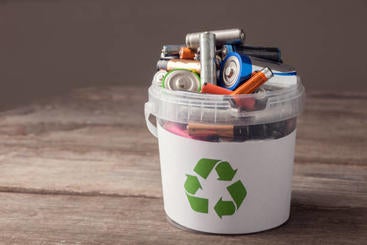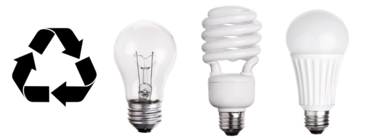What is Hazardous Materials Management?
Hazardous materials management is the collection, transport, processing, recycling or disposal of waste materials. Our Waste Management program help you manage hazardous chemical, radioactive, biohazardous, and universal waste safely and legally. We provide Waste Pickup Services where you can request pickup of hazardous, biohazardous, radioactive and universal waste online.
For more information, contact Hazardous Materials Management or call (951) 827-5528.
- What are my responsibilities for compliant waste management?
- Hazardous Chemical Waste
- Waste Determination & Waste Disposal Guide
- Biohazardous and Medical Waste
- How do I request Hazardous Waste Pick Up?
- Training
- How do I keep myself safe?
- Radioactive Waste
- Universal Waste
- Waste Containers We Provide
- Resources
Label your chemical, radioactive and biological waste.
To safely remove, transport, and store these hazardous waste items, accurate identification is essential. Except for a few exemptions, Hazardous Waste labels are required for all requested items. These labels must accurately reflect the constituents. Additionally, self-reactive material must not be placed in aggregated bags.
Exemptions
The following items can be grouped together under one label:
- Sample vials (same hazard class)
- Tox solids (no secondary hazard)
- Buffer Solutions
- Aerosols
- 1 Bag 1 Tag (all items inside the bag contain same constituents)
Properly segregate incompatible chemicals and appropriate storage of hazardous waste.
Manage your empty containers by requesting a waste pickup.
Empty containers that had been used to store hazardous chemical materials must be specially handled in order to ensure safety and protect the environment. These containers can only be discarded in trash receptacles if they have been completely cleared of hazardous chemical waste.
Special Requirements for Pesticide Containers
Never reuse a container that has contained pesticides. Read the manufacturer's labeling to see if there are any special precautions that you must take concerning disposal. If you cannot read the label or it is missing, contact Environmental Health & Safety (951) 827-5528. Never dispose of pesticides in any manner other than listed in the directions for use on the labeling. Inappropriate release of pesticides into the environment can cause human health problems, or problems for other animals and plants.
Additional Information
See the California Department of Toxic Substances Control Empty Containers Fact Sheet for more detailed information on empty container management.
Federal and State regulations define hazardous wastes as a substance which poses a hazard to human health or the environment when improperly managed. A chemical waste is considered hazardous if it is either listed on one of the lists found in Federal or State regulations or if it exhibits one or more of the four following characteristics:
Toxic - a chemical that poses a hazard to health or the environment (this can be a gray area).
Reactive - reactive wastes are those wastes that are unstable, explosive, capable of detonation or react violently with water.
Ignitable - ignitable wastes generally are liquids with a flash point below 60°C or 140°F (however, just because a material has a higher flash point, it still cannot be drain disposed).
Corrosive - corrosive wastes are generally aqueous wastes with a pH less than or equal to two (2) or greater than or equal to 12.5 (although UCLA policy includes any waste that is not neutral).
What are the guidelines for handling hazardous chemical waste?
The proper management of hazardous waste is essential to protect the health and safety of the University community and to ensure compliance with laws and regulations.
Make sure that no hazardous materials are placed into regular solid waste containers, flushed down the drain or otherwise inappropriately disposed. If there is any doubt, contact EH&S Hazardous Waste Operations at (951) 827-5528
Waste Determination and Waste Disposal Requirements
We are pleased to offer WASTe online waste pickup request services through our integrated Waste Management program. To use these services it is important that you properly determine the type of waste and review waste disposal requirements.
Description
Option of having laboratory generated Biohazard Waste (red bags, and sharps containers) collected on a weekly basis is now available. The collection will occur once a week, the day will be determined by the location of the generated waste. The goal is to reduce the use of autoclaves for biohazard waste processing.
Benefits to the Campus
- No cost to laboratories
- No need to create WASTe Labels for biohazard bags
- No need to autoclave Biohazard waste before disposing of biohazard bags into barrels
- Reduce cost of maintaining Autoclaves
- No spore testing for autoclaves
- No air quality issues due to biohazard autoclaving
- Assurance that labs are in compliance with Medical Waste Management Act storage requirements
Request Service
Please contact UCR Environmental Health and Safety Hazardous Waste Management for a walk-through to determine location of accumulation area and discuss specific lab needs. During the walk-through lab requirements, scheduling and volume of waste generated will be discussed. Please contact radiobiowastepickup@ucr.edu (951)827-5528.
Packaging and Labeling
- Before placing waste into biohazard bags, the bags require the PI's Name and location clearly written on them.
- Biohazard bags must be double bagged and closed with either autoclave tape or zip ties.
- No WASTe label is required for biohazard bags.
- Biohazard Sharps containers will require to be closed and have a WASTe label before placing directly in red barrels.
- Place red biohazard bags in a rigid, leak proof red barrels with a tight-fitting lid.oThese red barrels will be provided by EHS.
- Please do not overfill bags or red bins.
Storage
Red biohazard barrels can be stored within laboratories or in designated secure accumulation areas, depending on the specific needs and space availability of each lab. These barrels are equipped with wheels for easy mobility.
Environmental Health & Safety (EH&S) will collect the full bins and replace them with empty ones on the scheduled collection days.
Designated Waste Accumulation Areas
Shall be secured so as to deny access to unauthorized persons and shall be markedwith warning signs.
“CAUTION – BIOHAZARDOUS WASTE STORAGE AREA – UNAUTHORIZED PERSONS KEEP OUT” and
“CUIDADO – ZONA DE RESIDUOS – BIOLOGICOS PELIGROSOS – PROHIBIDA LA ENTRADA A PERSONAS NO AUTORIZADAS”
The biohazardous and medical waste storage area must be either locked or under direct supervision or surveillance, and remain closed to prevent unauthorized access.
Contact EH&S Waste Pickup Services at radiobiowastepickup@ucr.edu to request new sharps containers or visit EH&S office during business hours.
What are autoclave requirements for biohazard and medical waste treatment?
- The autoclave must be spore-tested monthly and all test results must be kept on file at the department for three (3) years. For guidance, contact EH&S Biosafety at 951-827-5528.
- The autoclave must have a chart recorder. All charts must be dated and kept by the department for three (3) years.
- All waste treatment runs must be listed on the autoclave log and the logs must be kept by the department for three (3)years.
Waste Accumulation Storage Tracking electronically (WASTe)
What is it?
Waste Accumulation Storage Tracking electronically or WASTe is a web based system that facilitates regulatory compliant labeling, tracking, collection and shipping of hazardous chemical, radioactive, and biohazardous wastes. The UC Risk & Safety Solutions application provides an interface between Principal Investigators, lab staff and other generators of regulated wastes and the UCR waste management staff.
This quick and easy-to-use system allows users to create tags for hazardous chemical, radioactive, or biohazardous waste in less than one minute. WASTe supports creation of tags for five types of waste: Chemical, Mixed, Radiological, Biological, and Universal. Lab & Facility staff can share created tag profiles, and administrators can create profiles for a single lab or for all users on campus. The system notifies Environmental Health and Safety staff when waste is ready for pickup. WASTe will enable researches and staff to dispose of hazardous waste in accordance with all state and federal regulations.
Anyone with a UCR NetID will be able to access the system at https://ehs.ucop.edu/waste/#/
For more information please contact EH&S at (951) 827-5528.
Resources:
WASTe Fact Sheet
WASTe User Guide: Roles & Workflow
WASTe User Guide: Admin & Waste Yard Staff Tutorial
Hazardous Materials & Waste Management
Introduction to proper determination and management of hazardous waste. Topics include labeling, storing, treating, and disposal of hazardous waste. Discussion includes physically hazardous, chemical, biohazardous, radioactive, and mixed waste.
Copyright: 2019 Time: 40 min Type: eCourse (online training)
Find this course and others in the UC Learning Center
- Wear your Personal Protective Equipment when you working around chemicals.
- Always review the Safety Data Sheet (SDS) for all materials before you begin to use the substances.
- Review the Summary of Waste Disposal Requirements.
Radioactive Waste
Please use WASTe for all Radioactive waste.
For questions, please call (951) 827-5528
Universal Waste
Our office accepts to following types of Universal Waste.
Batteries
Standard AAA, AA, C, D, ect. Computer batteries, cell phone batteries, etc.
Bulbs
Light bulbs of all kinds.
You can request pick up of your Universal Waste using WASTe.
You can also bring your waste to EH&S during business hours, please call ahead if quantities are large.
Campus Business Services accepts other waste, such as electronic waste, shredding and surplus items.
If you have questions on what is and is not Universal Waste, please contact EH&S (951) 827-5528.
Waste Containers (free of charge):
- RCRA Chemical Sharp Containers
- Biohazard Sharp Containers
- 5 Gallon Buckets for solid waste
- 1 Gallon Plastic Mayo Jar Containers (solid waste)
- Poly Bags
Resources:
Biohazard Waste Collection
Biohazardous and Medical Waste Disposal Requirements
Chemical Recycling ChemCycle Program
Containers: Closing containers
Containers: Empty container management
DTSC Empty Containers Fact Sheet
GHS Hazard Labels Infographic
Hazardous Waste Disposal Requirements poster
Hazardous Waste Determination Guidance
Hazardous Chemicals list
No Sharp in Trash sign
Radioactive Waste Management (Radiation Safety Manual)
UCR Empty Containers Fact Sheet
WASTe Instruction Manual
Videos
Check out these videos from King County in Washington State
Regulations:
California Hazardous Waste Treatment allowance regulation: http://www.ehs.ucsb.edu/units/hw/hwrsc/hwpdf/ab_966_bill_19980915_chapte.pdf
For more information, contact us at (951) 827-5528 or radiobiowastepickup@ucr.edu.

